Losing Your Spine Angle
- by Kelvin Miyahira
Losing Your Spine Angle
Here’s a true story about me in the third grade (don’t worry I’ll get to the golf later). I was so shy and embarrassed that I would get nervous whenever I had to read out loud in class. I would get sweaty palms and my heart would race just knowing the teacher would call on me at some point. Then there was this girl in my class named Lisa Goya that was a reading machine that would read fast, accurately and very articulately. She was as good as Katie Couric. I hated how good she was at reading.
Anyways, whenever I was called upon to read, I would stutter, read words wrong, say words out of order, and stutter some more, etc. This problem went on for weeks and one day I got sent to the office of some lady. I had no idea why I was to see this lady. So when I got to the office, I was shown pictures and asked to say what they were. “Tree, waves, sky, buildings, etc.”
“This is dumb,” I thought.
She says, “Hmmmmm, you seem all right.” Then she asked me read a paragraph. I read flawlessly. Every time she made me read, I was superb. By the third visit, the lady asks me if I was nervous when reading in front of the class.
“Yes, Ma’am I’m very afraid of making mistakes when reading out loud in class (I was so polite back then).” Little did I know but this lady was a speech pathologist. My third grade teacher thought I had a speech impediment.
Perhaps this story might illustrate how a misdiagnosis then subsequent mistreatment for the problem would not and could not ever fix the real problem. And so it is with diagnosing an error in your golf swing. If it is misdiagnosed, you could try as you may to fix what you think is the problem and the real problem never goes away. You could go from fix to fix, replace one flaw with another flaw and never arrive at the truth. So let’s take a closer look this month at losing your spine angle.
Retaining One’s Spine Angle
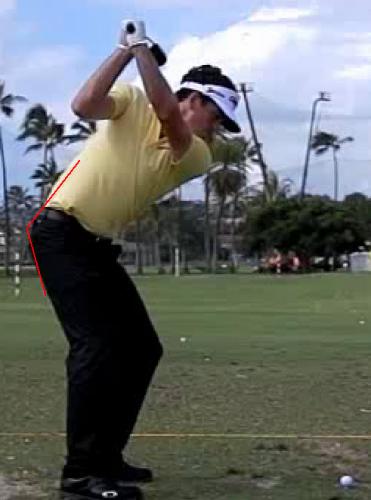
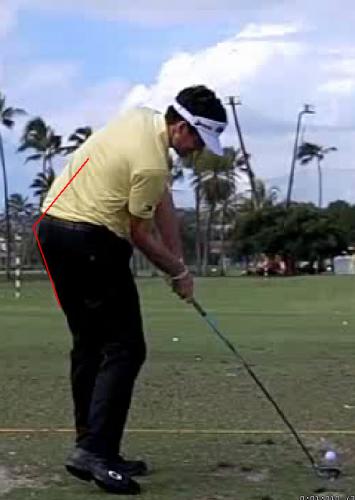
Here’s Keegan Bradley retaining his spine angle.
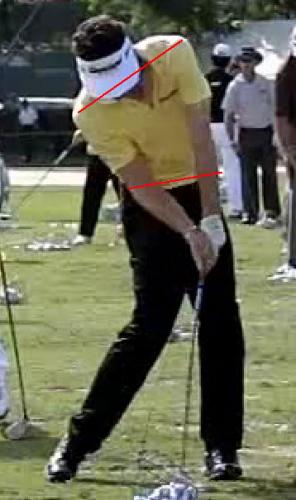
Here’s the great Ben Hogan retaining his spine angle.
Losing One’s Spine Angle
Now look at Daniel Chopra.
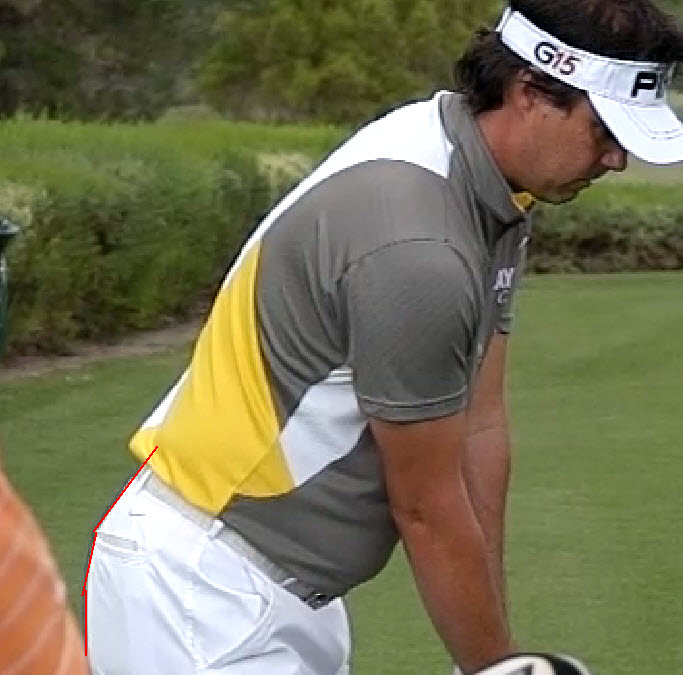
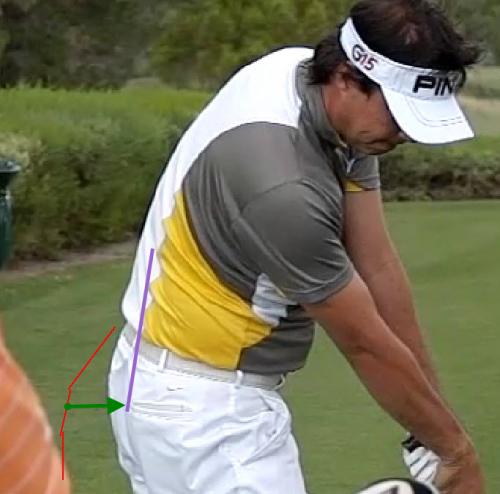
Looks very different from Hogan. You can clearly see how his upper spine is extending upwards along with his lumbar (lower spine extension). The green arrow is pointing to the direction his tailbone moved. Also you can see the change from the red line to the purple line indicating the change to a more vertical spine angle.
Other ways of losing one’s spine angle
Excessive sliding will also cause a loss of spine angle. The lower body, when sliding too far toward the target will also drift toward the ball thus causing a different sort of loss of spine angle. See Ricky Barnes below.
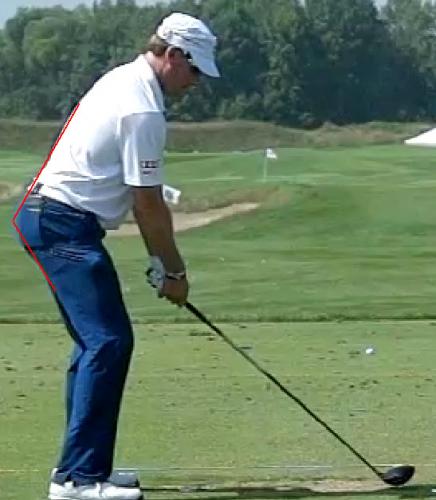
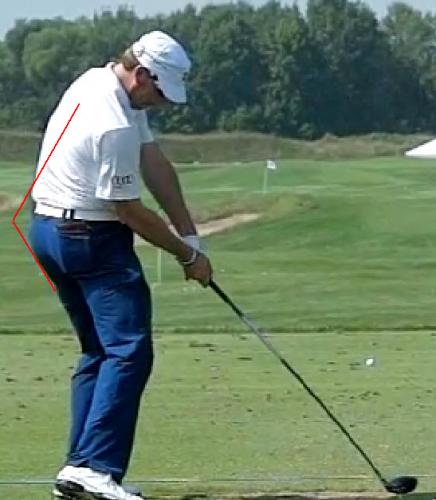
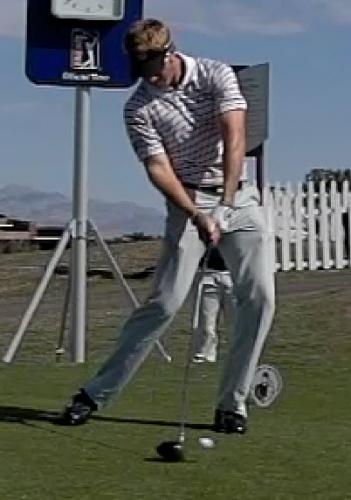
By sliding toward the target too far, Ricky loses his spine angle.
In a similar way, the stack and tilt crowd slides way left. Here’s Troy Matteson and Dean Wilson below.
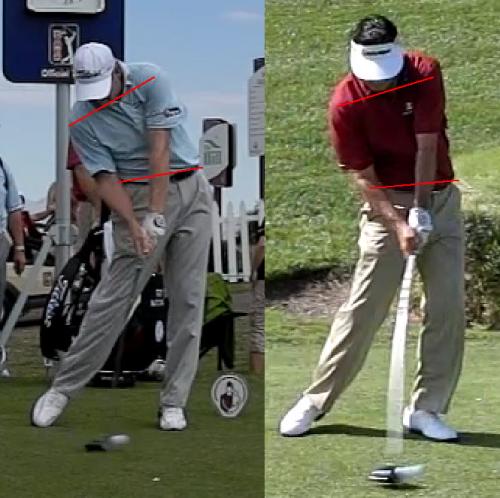
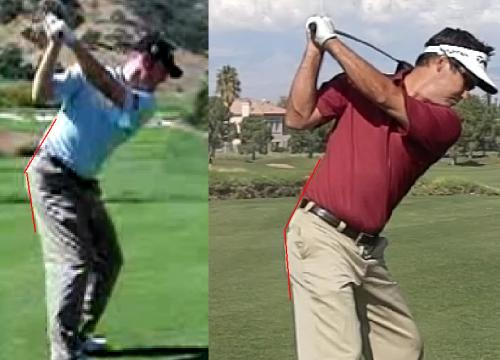
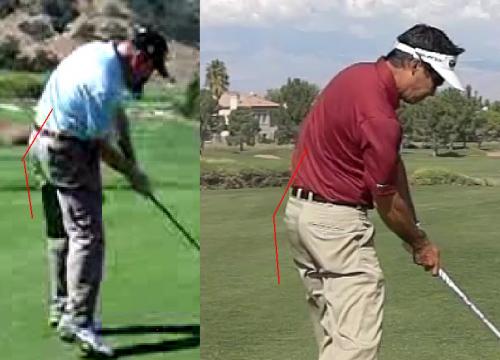
Different ways of retaining one’s spine angle
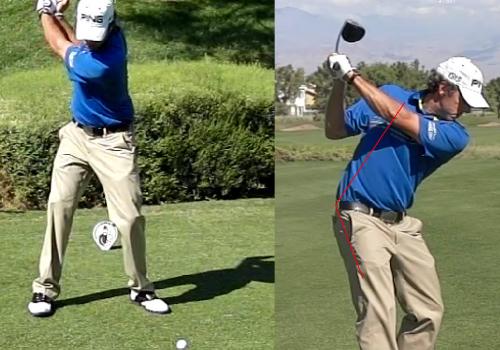
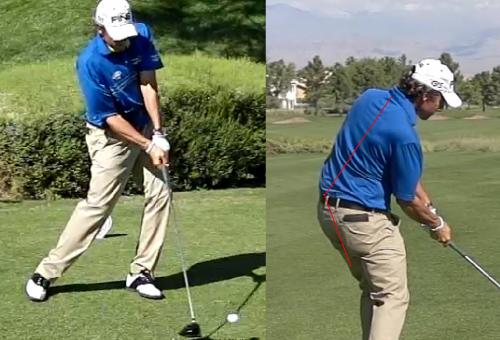
Here’s Chris Tidland, a Jim Hardy one plane swing guy with an uncommon and different way to keep his forward spine angle. However, because of the emphasis of keeping his spine angle constant and turning his shoulders perpendicular to the spine, his lower body cannot rotate. As a result, the upper body catches up to his hips very early, as you can especially see from front view. OK, Chris has “maintained his spine angle. But, is this the right answer?
Keep your head down and butt out
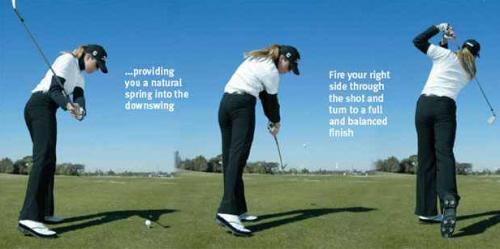

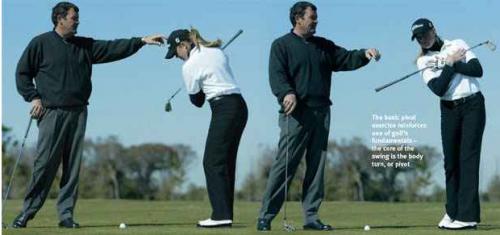
The world according to Leadbetter would have you maintain your spine angle by feeling like your tush is up against a chair or a tree throughout the swing. Does this look like Hogan??? Yikes!
Experimenting with Fixes
Here’s Andreas Kali, former mini tour player, member of the Danish National team and now teaching high level players in Denmark.
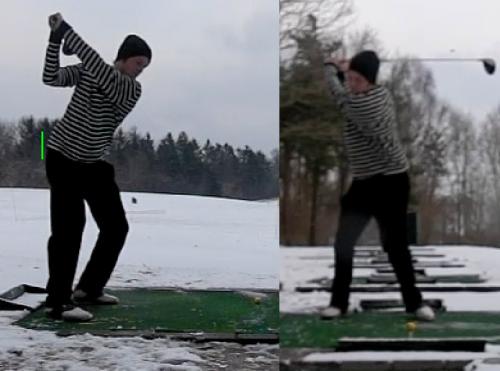
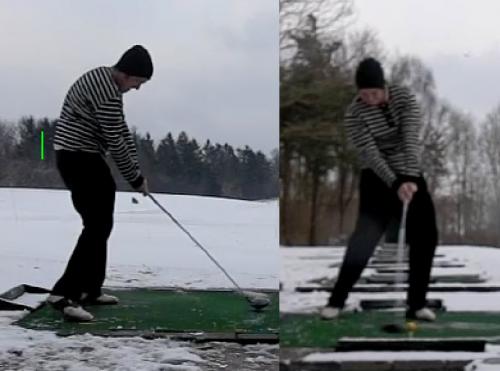
Andreas is losing his spine angle and you can see this causes a stall since his hips are barely open at impact. His hands are good enough to avoid a flip this way but this isn’t quite optimal. So let’s try to apply a traditional Leadbetterian fix to this problem.
Andreas has great body control and can do this experiment for us. So here he is using his golf bag instead of using a chair to be sure to keep his tush on the line.
Doesn’t he look at bit like Paula now? Can you see that this won’t solve his “shyness problem”?
Truth About Spine Angle Retention
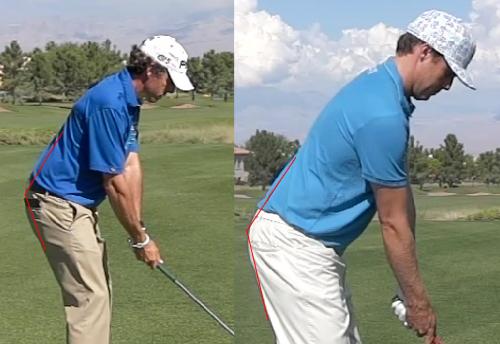
Now here’s a surprise. The fact is there aren’t many guys on tour who actually “retain the spine angle” throughout the swing. Chris Tidland is perhaps the closest of anyone on tour to actually do so.
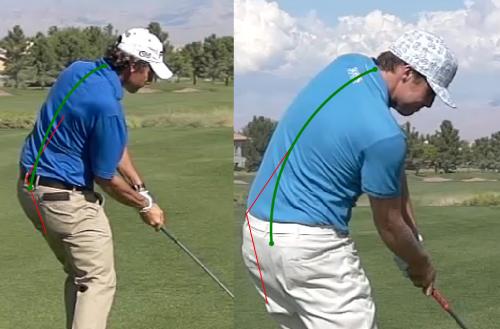
Chris really looks like his spine is in the same position at address and at impact. Compare his positions to Nick Watney, who is extending his lower spine and has more lateral bending of his spine and therefore has more hip rotation as well. Perhaps what we have here is a case of mass misdiagnosis.
Correct Interpretation
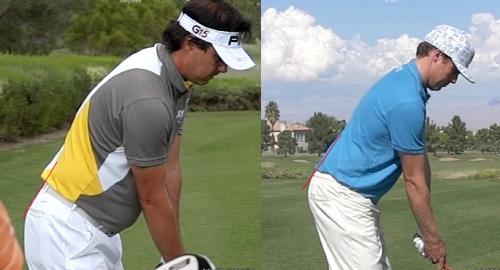
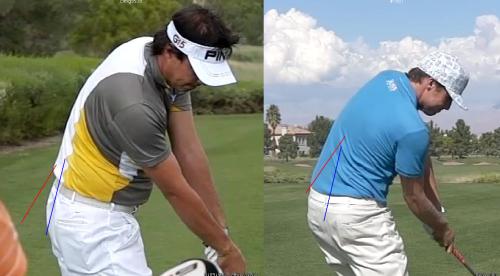
By the strictest definition, anyone extending their lumbar (lower) spine is actually losing their spine angle. That means Watney and virtually all other tour players (except Tidland) are losing their lower spine angle, and not retaining it.
Even the great Ben Hogan is losing his spine angle!
So what’s really going on?
The difference between Chopra and Watney is the lateral bending of the spine and massive rotation of both the rib cage area and the hips. Chopra does not have much, if any, of either one. That’s why his spine straightens and extends at impact whereas Watney’s does not. In reality, it is the lateral bending of the spine that causes the appearance of retaining one’s spine angle.
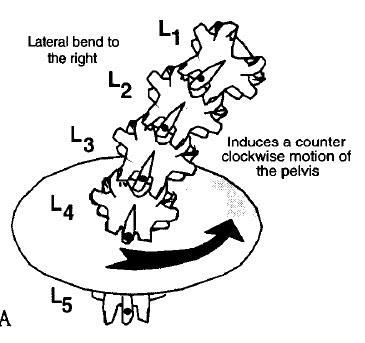
Remember the spine engine concepts? If you’re going to rotate your body correctly, you want to have lateral bending and lordosis. By omitting these key spine movements, Chopra never gets the connection between the spine facets and consequently has no ability to rotate his entire spine/body through impact as a unit. This is why we see a lower body stall in his swing. His upper body can continue to move but he loses potential for using the musculature of his lower body by failing to engage the “spine gears”.

Also, by trying to keep her butt against a chair, Paula does a similar thing to her swing. Her spine is more in flexion than lateral bend. That’s why she cannot rotate her body athletically and her head dips down, down, down. This is also shown by Andreas’ experiment.
The reality is, one cannot hold their lumbar spine stable and create full body rotation in a golf swing. It is impossible to disobey spine mechanics and move correctly.
Thus, what careless golf instructors have been looking at for years in terms of retaining/losing one’s spine angle has not been the spine! They have been looking at the left butt cheek and rib cage of the left side moving up and away from the target. And these movements are only possible due to lateral bending of the spine. So let’s look at how this works.
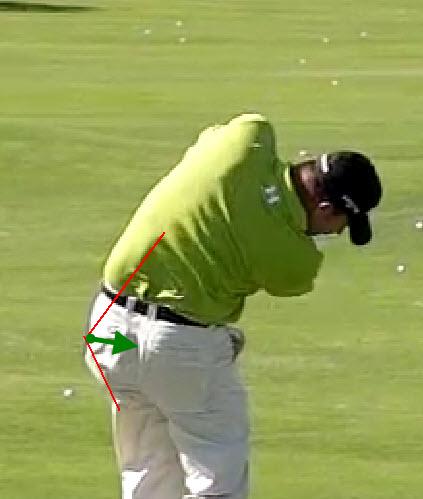
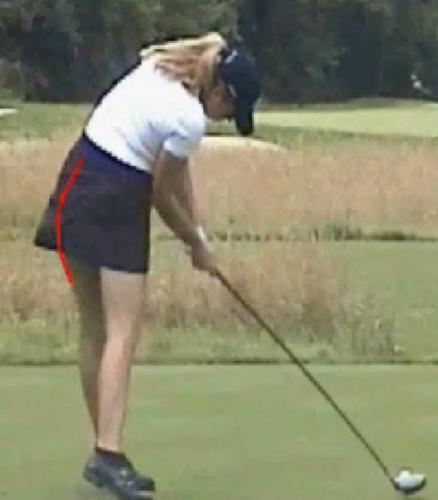
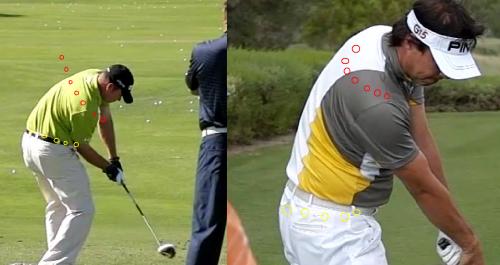
The red circles indicate right shoulder movement while the yellow dots show the right hip movement. Gainey’s dots converge vs. Chopra’s, which remain far apart. Also, how much left butt cheek do we see in Gainey vs. Chopra?
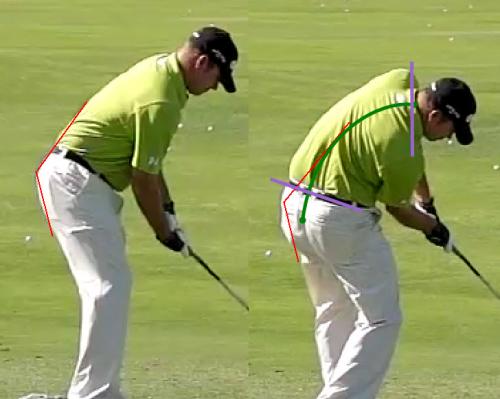
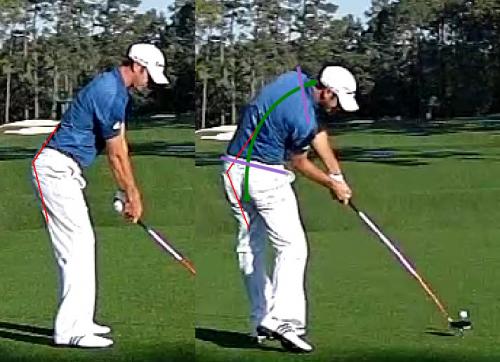
See the extension of Gainey's lower spine? The green arrow shows the tailbone moving toward the ball just as Dustin Johnson's did.
This movement is actually increasing the lateral bending since the lumbar spine and the right shoulder (top of spine) are being pulled together to create a tight connection of the spine gears at the critical moment of impact. This allows all the muscles of the body and the entire spine engine to explode through impact while keeping the spine safe according to Dr. Gracovetsky.
So, do you want to hit the ball like DJ and Gainey, or would you rather swing like Paula or Chopra? I’m sure they have excellent kinetic chain graphs that show hip deceleration to slingshot their shoulders, and then their shoulders speed up only to decelerate before impact to allow only their arms to swing through impact. Is that really what you scientists want us to do? Yummy Kool-Aid laced with cyanide.
Pelvis Shape
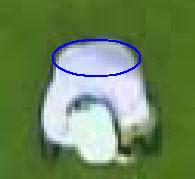
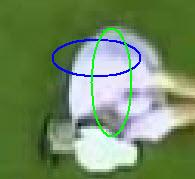
Since the pelvis is an oval shape, doesn’t it make sense that what you visually see from target line view at address will always look narrower than when the hips are turned open at impact or on the follow through? See distance of purple line increase as hips are turned open? This is what you’re seeing as spine angle retention, not the actual spine itself staying stable and in the same place.
Top View of JB
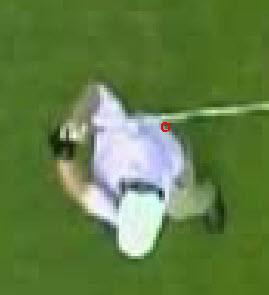
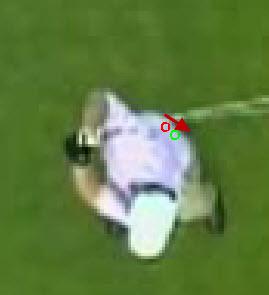
The sacrum tailbone moves from red to green dot from the top of the backswing to shift toward the target in transition. This movement is diagonal (toward right of target) and occurs for a very short period of time (let’s not get carried away here).
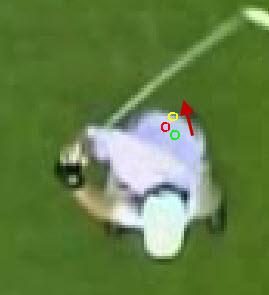

From there the sacrum moves away from the ball and then away from the target.
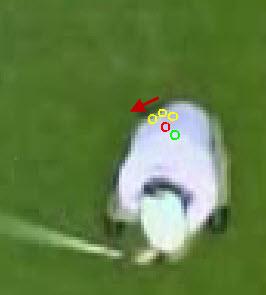
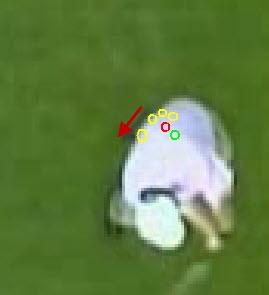
From there it begins to move toward the ball. Isn’t this what we’re seeing from target line view as well? You can see the letter “e” pattern of movement of the tailbone or sacrum from top view of JB Holmes.
See even Hogan’s lower spine moves toward the ball?
Rib Cage Movement
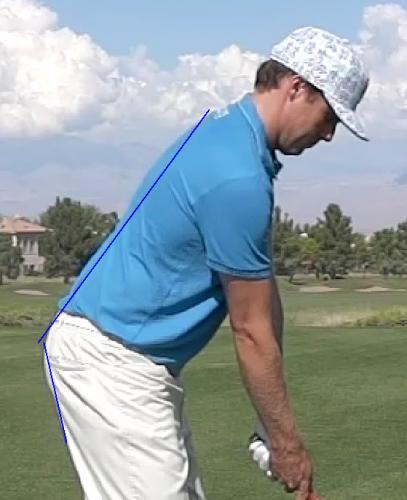
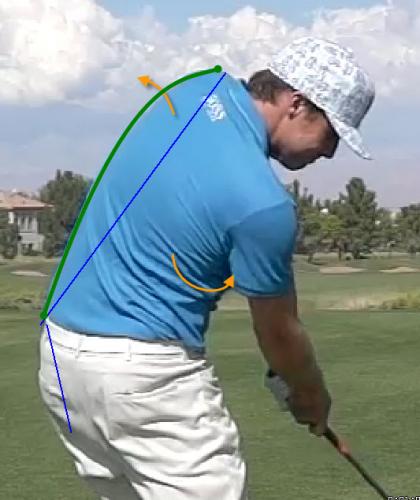
Similar to the hips, the rib cage area has an oval shape that is wider when the chest is turned toward the target than when square to the target line at address. Thus it also creates the illusion of retaining one’s spine angle when in fact the spine is bent into a very different shape than it was at address.
The Fix
So here’s Andreas working on lateral bending of his spine. It looks far more dynamic and powerful.
The bottom line is that misdiagnosing this fairly common problem won’t help you fix it just as going to a speech pathologist wasn’t going to solve my shyness problem. So be mindful of this when your instructor tells you to retain your spine angle. It’s just an illusion.
And maybe that’s the problem with golf instruction. Without ample knowledge of how the human body really works, huge chunks of information are missing, so therefore we believe in planes, kinetic chains and the spine angle remains. Perhaps it’s time to get out of the dark ages and solve everyone's shyness problem?